

Pulwell manufactures fiberglass (GFRP) rebars by combining the pultrusion process and an in-line  winding & coating process for the outside sand surface. The GFRP rebar is made from high strength glass fibers along with an extremely durable vinyl ester or epoxy resin. The glass fibers impart strength to the rod while the vinyl ester or epoxy resin imparts excellent corrosion resistance properties in harsh chemical and alkaline environments. For improved stiffness and mechanical properties high modulus of glass fiber with epoxy resin is also available. GFRP rebar significantly improves the longevity of civil engineering structures where corrosion is a major factor.
winding & coating process for the outside sand surface. The GFRP rebar is made from high strength glass fibers along with an extremely durable vinyl ester or epoxy resin. The glass fibers impart strength to the rod while the vinyl ester or epoxy resin imparts excellent corrosion resistance properties in harsh chemical and alkaline environments. For improved stiffness and mechanical properties high modulus of glass fiber with epoxy resin is also available. GFRP rebar significantly improves the longevity of civil engineering structures where corrosion is a major factor.
Pulwell’s GFRP rebar Features & Benefits:
High Strength-to-Weight Ratio – provides good reinforcement in weight-sensitive applications. 
Non-Corrosive– will not corrode under exposure to a wide variety of corrosive elements including chloride ions.
Non-Conductive – provides excellent electrical and thermal insulation.
Excellent Fatigue Resistance – performs very well in cyclic loading situations.
Good Impact Resistance – resists sudden and severe point loading.
Magnetic Transparency – is not affected by electromagnetic fields. Excellent for use in MRI and other types of electronic testing facilities.
Lightweight – easily transported and assembled in the field without need for heavy lifting equipment.
Summary of features GFRP VS. black steel rebars


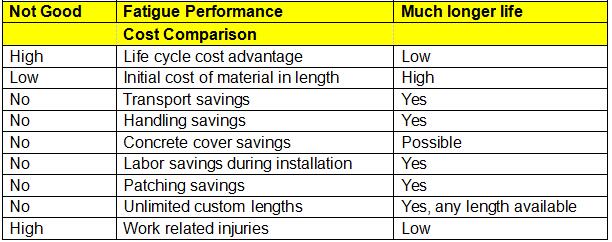
Pulwell’s GFRP Rebar Applications:
Six general categories of applications have been identified for which FRP reinforcement are suitable alternatives to steel, epoxy-coated steel, and stainless steel bars:
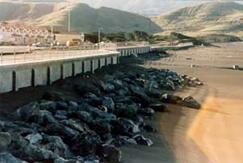 Reinforced Concrete Exposed to Deicing Salts-FRP bars can eliminate the corrosion problems and reduce maintenance and repair costs in northern climates where deicing salts are used every year
Reinforced Concrete Exposed to Deicing Salts-FRP bars can eliminate the corrosion problems and reduce maintenance and repair costs in northern climates where deicing salts are used every year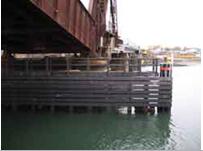 on roads and pavements. Applications most likely to benefit include: parking structures; bridge decks; jersey barriers, parapets; curbs; retaining walls and foundations; roads and slabs on grade; and many others.
on roads and pavements. Applications most likely to benefit include: parking structures; bridge decks; jersey barriers, parapets; curbs; retaining walls and foundations; roads and slabs on grade; and many others.
Structures Built in or Close to Seawater-Corrosion of steel reinforcement is a common problem in structures built in or close to seawater. Examples of possible applications: quays; retaining walls; piers; pilings; jetties; caissons; decks; bulkheads; floating structures; canals; roads and buildings; offshore platforms; swimming pools and aquariums.
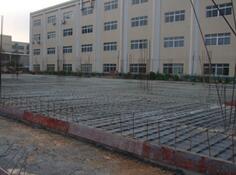 Applications Subjected to Other Corrosive Agents-Chemical processing industries of all types, as well as wastewater of domestic or industrial origin, constitute major sources of corrosion for steel reinforcement. Typical applications include: wastewater treatment plants; petrochemical plants; pulp and paper mill and liquid gas plants; pipelines and tanks for fossil fuel; cooling towers; chimneys; mining operations of various types, nuclear power plants; and nuclear dump facilities.
Applications Subjected to Other Corrosive Agents-Chemical processing industries of all types, as well as wastewater of domestic or industrial origin, constitute major sources of corrosion for steel reinforcement. Typical applications include: wastewater treatment plants; petrochemical plants; pulp and paper mill and liquid gas plants; pipelines and tanks for fossil fuel; cooling towers; chimneys; mining operations of various types, nuclear power plants; and nuclear dump facilities.
Applications Requiring Low Electric Conductivity or Electro-magnetic Neutrality-Using steel bars in applications where low electric conductivity or electromagnetic neutrality is needed often result in complex construction layouts, if such use is possible at all. Potential applications are: aluminum/copper smelting plants; manholes for electrical and telephone communication equipment; structures supporting electronic equipment  such as transmission towers for telecommunications; airport control towers; magnetic resonance imaging in hospitals; railroad crossing sites; and military structures needing radar invisibility.
such as transmission towers for telecommunications; airport control towers; magnetic resonance imaging in hospitals; railroad crossing sites; and military structures needing radar invisibility.
Applications in Tunneling / Boring Requiring Reinforcement of Temporary Concrete Structures: Structures including mining walls;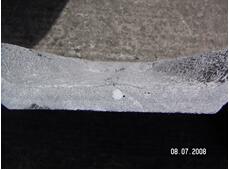 underground rapid transit structures and underground vertical shafts.
underground rapid transit structures and underground vertical shafts.
Applications in Weight Sensitivity or Thermally Sensitivity Structures: Concrete construction in areas of poor load bearing soil conditions, remote geographical locations, sensitive environmental areas, Apartment patio decks; thermally insulated concrete housing and basements; thermally heated floors and conditioning rooms, or active seismic sites posing special issues that the use of lightweight reinforcement will solve.
GRC Panels: The need for spacing between the rebar and the surface of the concrete is reduced. This allows for thinner projects and more flexible designs using less expensive & heavy concrete.
Stirrups, Shapes and Bends
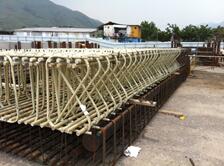 Bends in Pulwell GFRP Rebar are fabricated by shaping over a set of molds or mandrels prior to curing of the resin matrix. Field bends are not allowed. All bends must be made at the factory. All GFRP rebars exhibit a strength reduction through the bent portion of the rebar, which is recognized by all the consensus design guidelines. Research has shown that bends typically maintain 38% to 50% of ultimate tensile strength through the radius.
Bends in Pulwell GFRP Rebar are fabricated by shaping over a set of molds or mandrels prior to curing of the resin matrix. Field bends are not allowed. All bends must be made at the factory. All GFRP rebars exhibit a strength reduction through the bent portion of the rebar, which is recognized by all the consensus design guidelines. Research has shown that bends typically maintain 38% to 50% of ultimate tensile strength through the radius.
While most standard steel rebar shapes are available, there are a handful of limitations that influence the economics of the detailing. Bends are limited to shapes that continue in the same circular direction. Otherwise lap splices are required.

Generally, pairs of U or C or L - shaped bars are more economical. Z - shapes or gull- wing type configurations are not very economical. A 90- degree bend with 12db bar diameter, pigtail used to shorten development length is just as effective as a J- shape as per ACI 440.1R.
The maximum leg length on any bend can be 10ft (2.5 m), but we suggest it to be less than 5ft ( 1.5m) if possible.
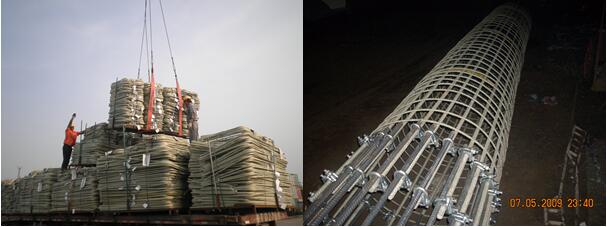
According to ACI 440.6-08 “Specification for Carbon and Glass Fiber-Reinforced Polymer Bar Materials for Concrete Reinforcement”, the Min. Bend Radius can be 3 times of the rebar diameter, but we suggest the following radius to reach better performance at the bent portion.
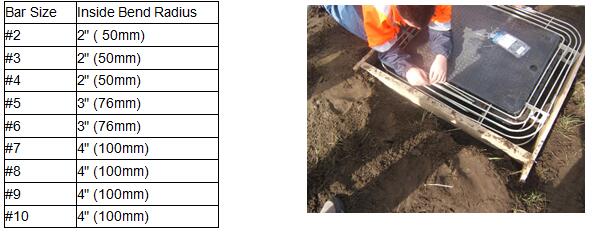
It is recommended that you work with the factory in the early stages of design, as not all standard bends and shapes are readily available.
Package in Coils and Field Forming of Large Radius Curves :
 Due to the low modulus of the Pulwell GFRP bar, it is possible to pack the rebars especially small sizes ( below 12.7mm) into coils with several hundred meters per roll , or field form the bar into large radius curves.
Due to the low modulus of the Pulwell GFRP bar, it is possible to pack the rebars especially small sizes ( below 12.7mm) into coils with several hundred meters per roll , or field form the bar into large radius curves.
The GFRP rebars will naturally straighten when the coil is unrolled.
When the rebar is formed into big radius curves, a bending stress is resulted in the rebar. A radius smaller than those in the following table would exceed the long term sustained stresses allowable. The table gives the minimum allowable radius for induced bending stresses without any consideration for additional sustained structural loads.

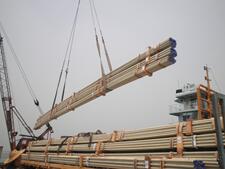 Handling and Placement
Handling and Placement
Follow guidelines in ACI440.5-08 “Specification for Construction with FRP Bars”.
In general, field handling and placement is the same as for epoxy or galvanized steel bars.
Do NOT shear FRP bars. When field cutting of FRP bars is necessary, use a fine blade saw, grinder, carborundum or diamond blade.
Sealing the ends of FRP bars is not necessary.
Support chairs are required at two-thirds the spacing of steel rebar.
Plastic coated tie wire is the preferred option for most projects. When completely non-ferrous reinforcing, i.e., no steel is required in the concrete, nylon zip ties (available from local building materials centers) or plastic bar clips are recommended.
Care should be exercised to adequately secure GFRP in the formwork. GFRP rebars shall “float” during vibrating because of low weight, especially in precast applications
Properties Tested to Guarantee the Quality
Normal main properties tested according to ACI 440.3R , include
1.Barcol hardness and cross area
2.Tensile properties
3.Bond Strength
4.Shear Strength
5.Fiber content
No.20 Lianhong Road, Torch High-Tech Industrial Zone, Zhongshan City, Guangdong 528437, PRC
Copyright © 2025 Pulwell Composites Co.,Ltd. All rights Reserved
Tel:+86-760-86133399, Fax:+86-760-86133398